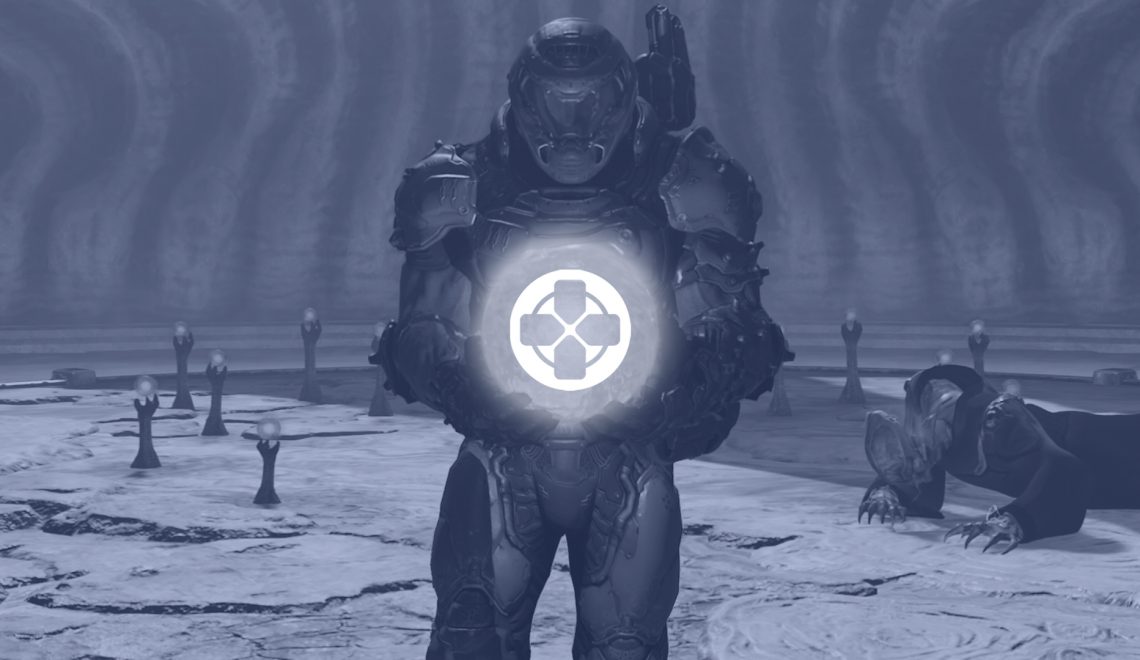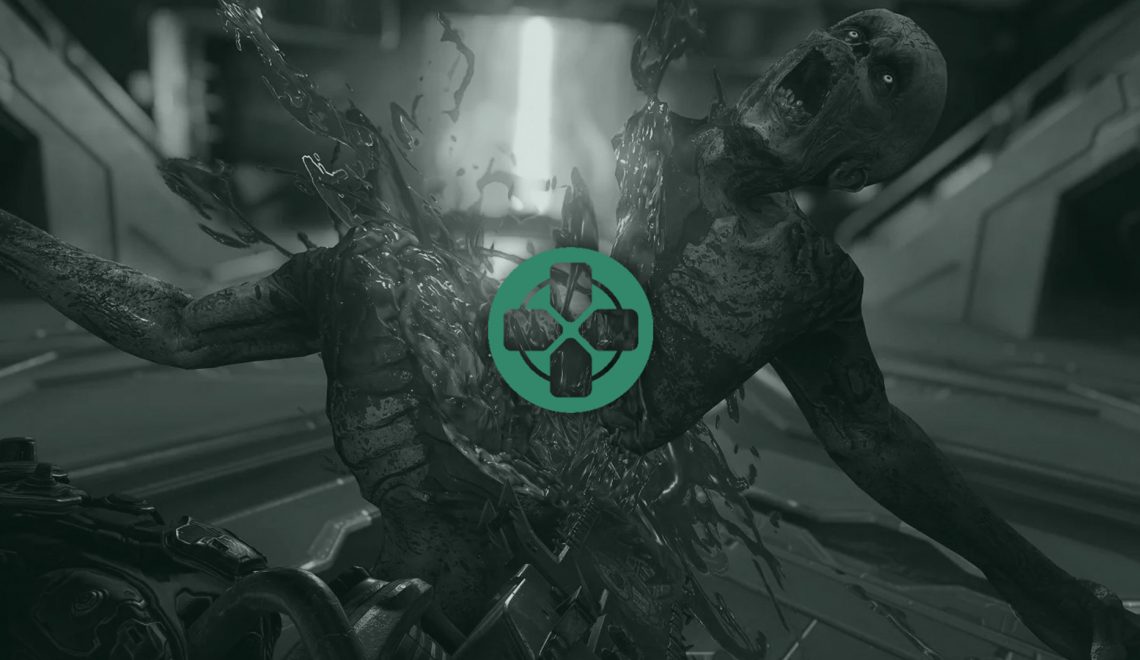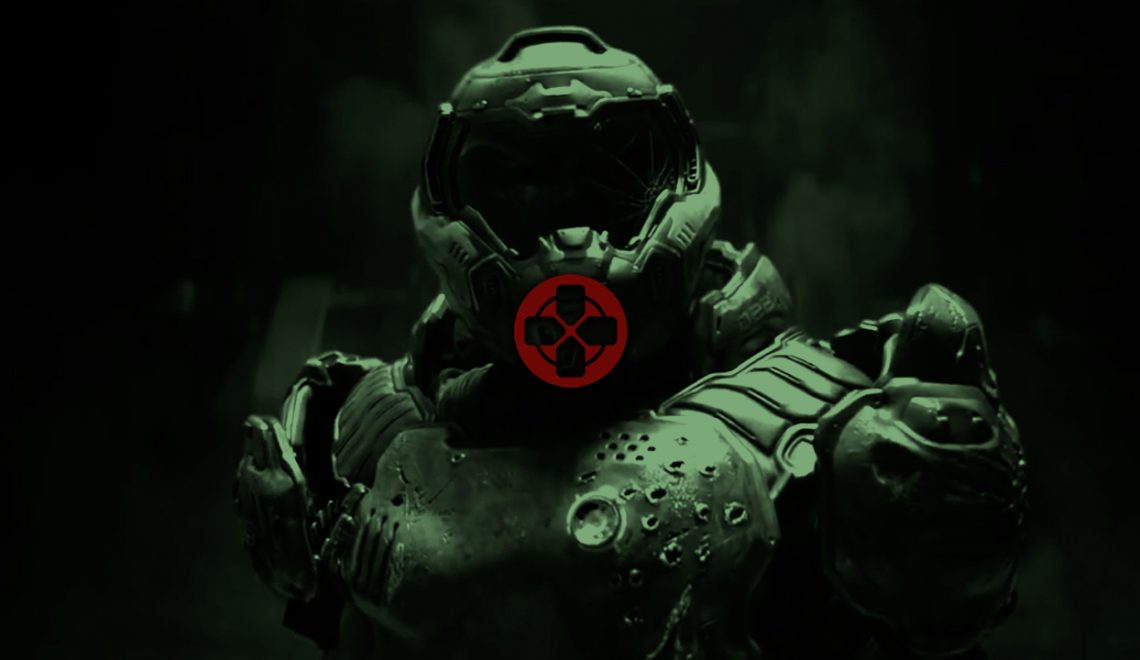You know that moment when a game transcends beyond its own exaggeration? Like when Metal Gear Rising: Revengeance starts with Raiden tossing a Metal Gear RAY into the sky that he slices into dozens of pieces, or when Dead Space 3 ends with killing a literal Necromorph moon. Videogames can either own or be hurt by instances like these that shatter suspension of disbelief, but for Kratos, that’s just an everyday thing. God of War specializes in its anti-hero defying odds for the sake of unrestrained, grotesque power fantasies. Pandora’s Temple and Ares couldn’t crush Kratos. Perseus and Theseus – other sons of gods – were mere footnotes in his quest to defy the Sisters of Fate. Now, with a legion of Titans at his side to help kill Zeus in God of War II’s cliffhanger ending, how could Santa Monica Studio live up to a ridiculous setup like that? If there’s one thing I’ve come to know about the team, it’s that they’ve rightfully earned to be among Sony’s first-party crowd; they’ve pushed the hardware boundaries of PlayStation consoles much like Naughty Dog and Guerilla Games. Maybe not always in the realms of design or narrative, but artistically? Graphically? I don’t think that’s up for debate. For Santa Monica, God of War III demonstrates the studio at its near-best in nearly every way with a game that defines … epic. First, let’s take a look at how the team got there.
Analyze
There were bold plans for God of War III. According to the director for the first God of War, David Jaffe, Zeus would’ve been killed at the beginning and – because of the “vacuum” the Greek pantheon left in the world – gods from other religions would’ve swept into Greece to fight for control over its people. Kratos would then battle Egyptian and Norse gods to the point of wiping out all of the main religions’ deities, resulting in the quiet birth of a God man born of a virgin because “man always needs something to believe in.” It explains why there’s a mural in God of War II of three men on camels traveling toward a star. Regardless, I can see why the story’s grand scope was understandably scrapped to leave the future open for potential spins on the franchise.
Anyway, you remember Cory Barlog? The frank, sincere, kinda goofy director for God of War II? He helped write the script and plan out levels for the third game for several months, but felt it was time to move on after discussions he had with creatives outside of Santa Monica. He departed and studied under George Miller for a while, helped with the development of Avalanche Studios’ Mad Max, and joined Crystal Dynamics to direct the cinematics for the Tomb Raider reboot. But I’m getting ahead of myself. We’ll come back to Cory Barlog after a couple videos. That’s not the last we’ve seen of him.

Barlog’s promotion to director may have been more of a surprise, but Stig Asmussen rising as his successor is more immediately understandable. He originally attended an architectural school and quickly discovered that his desire for form over function wouldn’t jive in the field. He became a bartender for a while and immersed himself in videogames during the day. His passion piqued for the medium after playing Resident Evil, which he considered a groundbreaking synthesis of film and gaming at the time. He eventually came across an ad describing the Art Institute of Pittsburgh in the defunct videogame magazine Next Generation, so he saw that as his chance to get into game development. He went on to attend and graduate with a degree in Computer Animation Media, worked with Atari for a few years on Gauntlet: Dark Legacy and Dr. Muto, and landed a job as an environment designer at Santa Monica for the first God of War. His strong presence and organizational skills earned him the title of art director over God of War II. He remained with the studio because of the freedom Sony gave the team and how much his peers pushed his creativity, so he was asked if he wanted to be God of War III’s director. He accepted. As a side note, he’s currently a director at Respawn Entertainment for its Star Wars title Jedi Fallen Order … I’m looking forward to seeing more of that.
With God of War II remaining put on the PlayStation 2, the team was eager to conclude the trilogy on the PlayStation 3, and they’d need it. They started out by porting the second game’s engine to the next-gen console. Once they ironed out the input of foundational mechanics and movement, they filled in and replaced parts of the old engine piece by piece. One trick that streamlined development is how programmers would give tools to designers to tweak things on their own time, rather than taking up the programmers’ time. They’d need it given how ambitious the game’s concepts were to realize. Very little materials were reused. The game took inspiration from Shadow of the Colossus by making the Titans moving levels for Kratos to fight and climb on, which took a massive amount of time and resources to figure out. All of the cutscenes were rendered in-game, too. It’s no wonder why the team went from 90 to over 100 members in doubling the graphics team after the game’s showing at E3 2009.
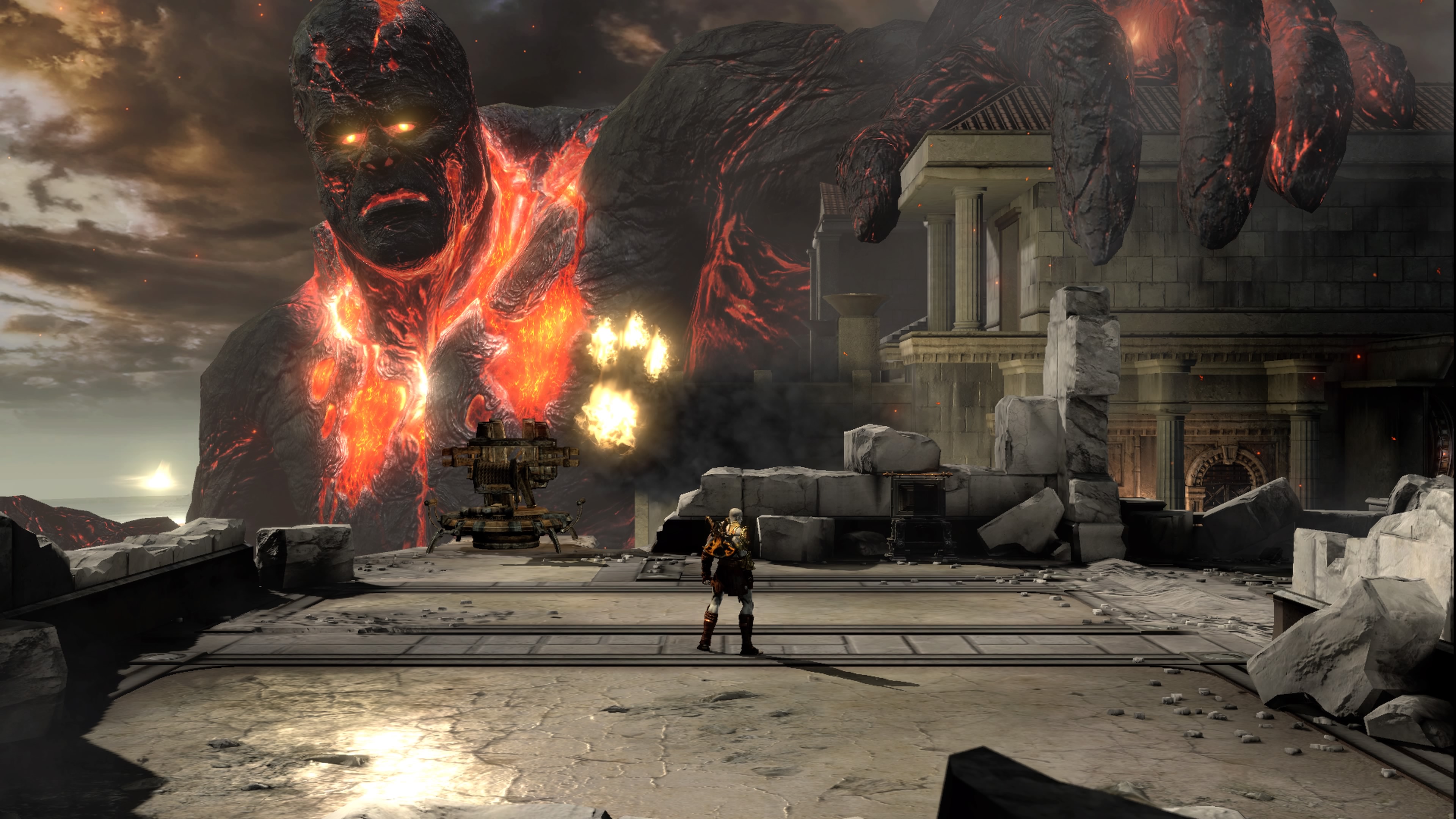
You can’t climb Atlas in this game, but the two other titans you’ll come across are a marvel to behold as you venture across, say, one of their arms, which can go from behind a floor to a wall in an instant.
Even though the budget was a sweat-inducing $44 million, it paid off when God of War III became and (up until recently) remained the best-selling title in the franchise by selling 5.2 million units worldwide, around half a million more than what the first God of War moved. The game also outsold its competitors during the month of its release with over 1 million copies sold, also breaking records in terms of speed in for the franchise. I can see why Sony would see the benefit in touching up the game with a smooth 60 frames-per-second and resolution bump for the PlayStation 4 courtesy of Wholesale Algorithms. It’s the version I’ll be playing for this review.
You know, it’s a real bummer when a series of movies, games, or what have you has that one stinker fouling up the bunch, or it just doesn’t live up to the lofty pedigree of its prequels or sequels. The first God of War may have had its flaws, but it overcame those with its strengths in Kratos’ tragic backstory, the combat, and an ambitious world. God of War II improved and expanded on everything to a degree that’s hard to top. God of War III … well, I can say it hardly disappoints. Allow me to explain.
Diagnose
Uncharted 2: Among Thieves was the first game that blew my mind with in-game cinematics. I was so used to titles like Kingdom Hearts that oscillate between in-game cutscenes with characters that have wooden faces, small sets of generic animations, and flapping mouths, and then prerendered cutscenes with all those problems wiped away. Naughty Dog caught me off guard several times when it would seamlessly transition between gameplay and cinematics, and if I’d been old enough to play God of War III around its release, 15-year-old me would’ve been swept away by its graphical prowess, too. The leap between the first and second games is with refinements and optimization to scale, animation, and detail. Comparing the jump from the second to third game is like apples and oranges. There’s a snappiness and lively expression in the made-from-scratch animation that shines through, even if there are some slip-ups with voice synchronization. Character models are immensely detailed with a vast range of expressions and intricate detail (as an example, Kratos’ character model has a memory footprint that fits on two PlayStation 2 consoles). The insane lighting and shadows are far more dynamic, flickering and casting with differing intensities and colors across environments, objects, and characters. Of course, it wouldn’t be God of War without an overwhelming sense of scale. This game takes it even further by drawing inspiration from Shadow of the Colossus. Two major sections of the game involve Titans as morphing battlefields, so you’ll be alternating between fighting other enemies and climbing on Gaia and Chronos as they respectively react to you defending and attacking them. They’re easily the size of the last Colossus that Wander defeats, and even though they don’t behave on their own like the Colossi, the pre-determined paths of platforming and combat will leave your mouth agape nonetheless.
One aspect I praised about God of War II is how the scale and scenery are ever-changing and purposefully intended to make you feel like you’re going on a far-reaching adventure. From the Pits of Tartarus to the top of Mt. Olympus, I think what’s more impressive about God of War III is how fast Kratos can close distances in this entry by traveling from the top of Mt. Olympus to Hades in a matter of minutes. There’s also a pleasant sense of connective tissue between all the environments. Places you saw near the beginning will come into play later; you’ll suddenly revisit or rediscover old places you didn’t realize were right around the corner. Even though the game’s linear, these fun moments remind me of Ratchet & Clank and Dark Souls’ interconnected level design, which helps God of War III offset some of its uneven pacing since you’ll unexpectedly linger in some places for a while and be in others for less than twenty minutes. It gives the impression that Santa Monica was reaching a bit to maintain environmental diversity because there are loads of dark, gloomy areas, though the settings do make sense in the context of the story’s apocalyptic trajectory. Part of this struggle to keep things different is how the journey is vertically constrained to areas closely below, around, and on top of Mt. Olympus with some places revisited, whereas God of War II is an incredibly horizontal adventure from A to B, having the luxury of being more exotic with areas spread far and wide. It boils down to the third game exploiting a different brand and feel of adventure, which comes close to matching the prior game’s spectacle artistically. Technically? As I already implied, God of War III has the definitive edge.
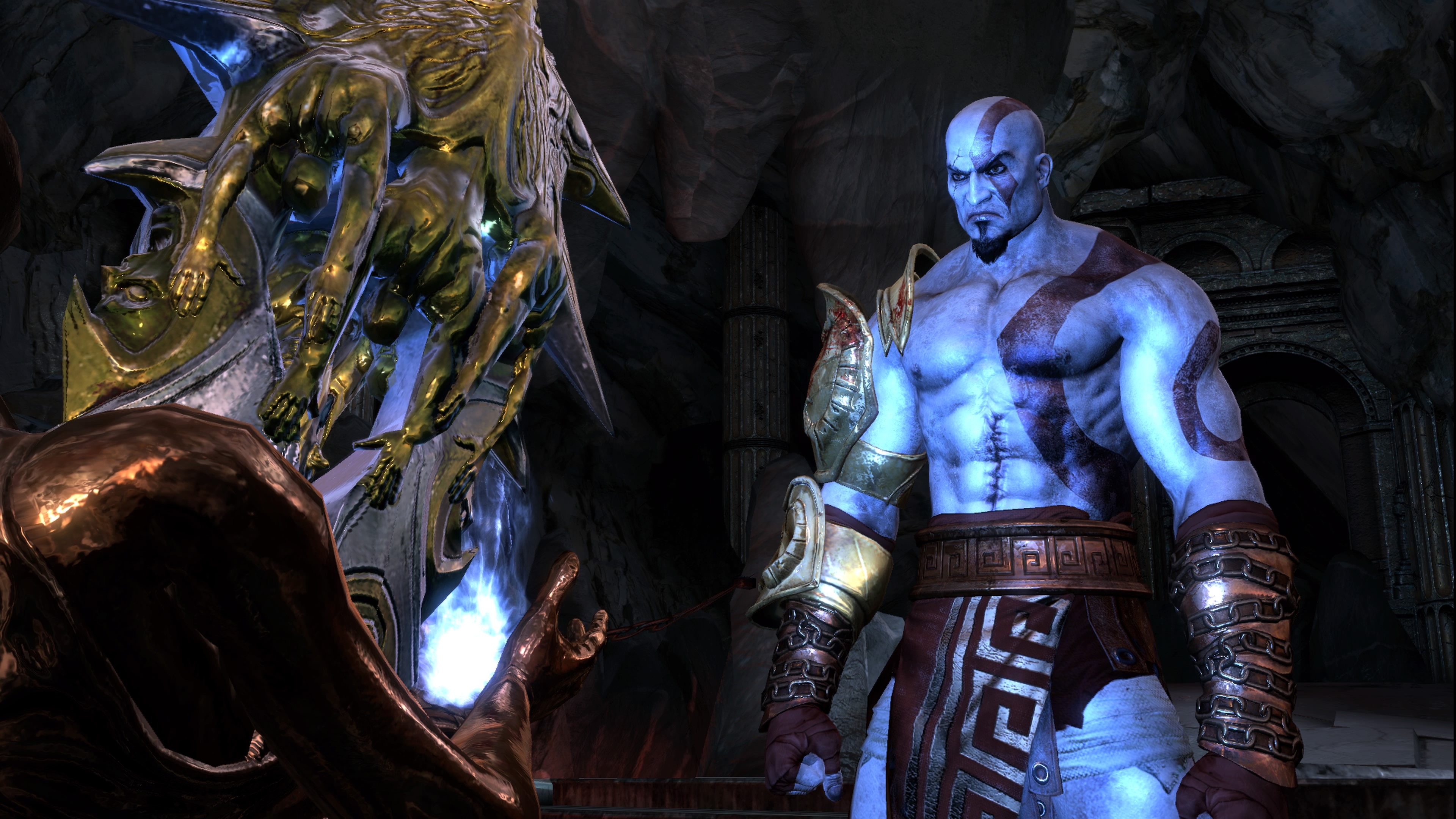

Some of the objects look strangely … slick, for lack of a better term? But like, some scenes with Kratos floored me with how detailed his model and animation are. Uncharted 2 had the leg up at the time with its mo-cap and unbelievable facial animations, but for hand-made animations? Their first PS3 title? Santa Monica should be applauded.
The game excels with more environmental storytelling and a cohesive presentation of Kratos’ impact on the Grecian world. You’ll come across manuscripts in the underworld written by mythological figures and others connected with Kratos. Many will weave in snippets of how their terrible fates became even worse due to his past actions. That blame is even more pointed and present with the deeds you’ll do in the here and now. The game begins where the previous one left off with Kratos leading the Titans up Mt. Olympus to wipe out the Olympians, and that’s exactly what you do with Poseidon’s death at the start. Then, Kratos manages to get to the top of Mt. Olympus, but Zeus casts him down into Hades where he loses much of his power by falling into the Styx River. Athena appears to him in a spirit form and offers her guidance to defeat Zeus. Kratos is rightly concerned about her motives, but he proceeds onward and slowly regains new powers by stripping other gods of their weapons and abilities. He gains Hades’ chained Claws and the dead begin roaming the earth with no one to contain them. Kratos rips Helios’ head off and strips Hermes of his boots, but the world is subsequently afflicted by never-ending nightfall and disease. The games have never shied away from Kratos’ cruelty toward the innocent. This one, however, sticks it in your face.
There’s tension between the gameplay and story that respectively forces players to commit even more gruesome, indulgent violence and guilt trips you for doing so. This is the first God of War to make me pause and sit back in horror when Kratos uses a hapless woman as a prop to hold a gate open with the crank collapsing on her, leaving nothing but a pool of blood and ambiguous appendages. You’re led into thinking you can save her as you escort her out of Poseidon’s chambers, but it’s a ruse concealing Kratos’ ulterior, dehumanizing motives. Similar instances from past games are heightened here by murdering humans that get in your way during combat and platforming, who plead for your help and mercy as you slaughter them. All the while, you’re constantly reminded of the havoc and suffering you cause as civilizations crumble and nature falls apart. Kratos is usually silent in the face of these accusations, but he tells all to Athena: “Let them suffer. The death of Zeus is all that matters.”
Even though prior titles made me squirm at the depths of Kratos’ depravity, this one forces you into the most disturbing circumstances that, dare I say, reminds me of Spec Ops: The Line’s brilliant metacommentary on violence for entertainment at a much lesser level. Asmussen even said, “Anything that goes in, that we look at and say, ‘That’s too brutal,’ or is worse than the definition of ‘This is what Kratos would do given the situation,’ it goes in and we keep it. Anything that we do and look at afterward and say, ‘Hey, this just doesn’t fit. It’s too over the top,’ we pull back. And there are a few things we actually pulled back on.” One such example is removing the Sixaxis functionality of the DualShock 3 to snap Hera’s neck. The final product has Kratos do this automatically, but I believe Santa Monica should’ve kept stuff like that in. Players should be held captive as the catalyst for Kratos’ sins in intimate ways like this because this is the cost of unbridled power and revenge. The Ghost of Sparta has closed his heart to everything and players have to learn to do this as well. In the end, the game shows how there ain’t no rest for the wicked. Even when they succeed in their destitute, shortsighted pursuits, there’s nothing to hold onto when you’ve destroyed everything. It sounds like the game contains deep themes critiquing itself, but I wouldn’t call it groundbreakingly subversive; I’d say it’s more theatrical than profound in execution.

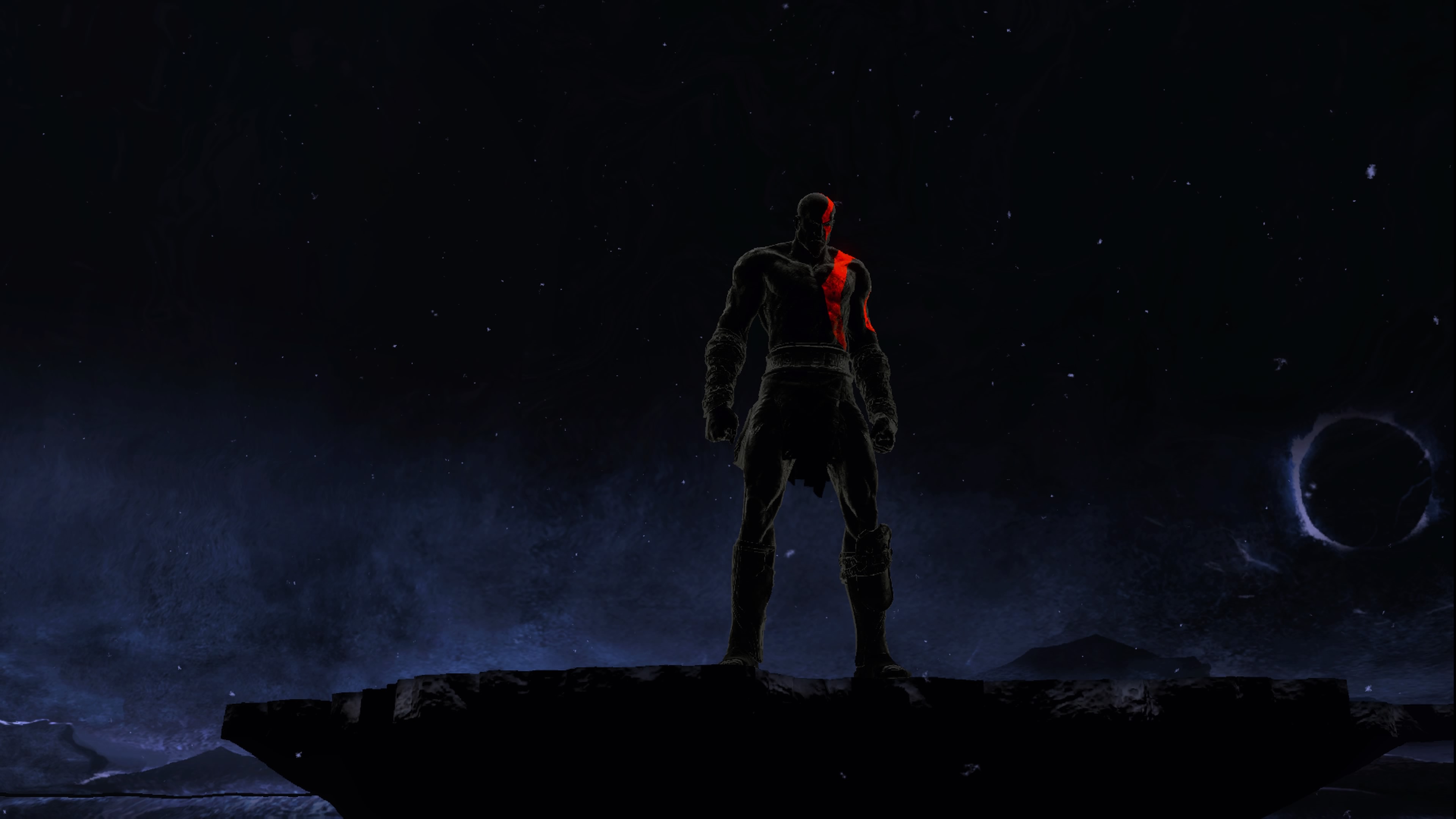
There was originally going to be a bigger fight between Gaia, Zeus, and Kratos at the end, but this was cut down to make way for a dreamlike sequence taking place in Kratos’ soul, sort of like when Ares forces him to confront his demons at the end of God of War. It’s clear that Kratos knows who he is and that he’s projecting his self-hatred on the Olympians (who are still, admittedly, deserving of judgment). One thing I love that the series highlights is the prevailing theme of sons killing fathers in Greek mythology. I learned that Uranus feared Cronos killing him. The same was true of Cronos with Zeus. The cycle continued with Kratos; evil begets evil.
Speaking of theatrical, I’m reminded of God of War II and the over-the-top delivery and lofty writing for the dialogue. I consider its grandiosity intentional, but for some reason, God of War III actually goes a little overboard to the point of making me laugh out loud, even with the bombastic, adrenaline-pumping music. Hermes, Daedalus, Zeus, Hephaestus – they’ve got a bunch of quotable lines, but Kratos is the real star with the way he says winners like “You will not live to see the end of this day!”, “I only see what I have come to destroy,” and “They will fall as well.” If you thought he had great one-liners before, this game has too many where I couldn’t keep a straight face. Writer Marianne Krawczyk mentioned how she didn’t want the dialogue to be authoritative and lofty-sounding without reason and intention, and sure, some moments were surprisingly subdued. Most of the time, God of War III’s writing and delivery is just hilarious, and … I think that’s a great thing? All in all, if I had to summarize the pros and cons of the story, it seems like it tries to stretch itself a bit too far by setting back Kratos with some unexpected detours while strangely moving forward quickly during key moments. This issue is subtly rather than egregiously noticeable, I might add, and doesn’t detract from the game’s bizarre mix of funny and mature moments.
If I could go back and change one thing about my God of War II review, it’d be how I said it has the best combat in the series by not overwhelming players with fluff while adding enough new things that feel essential and important. I think that praise should go toward God of War III instead. The moveset for Kratos’ iconic blades is nearly identical to God of War II’s combos with the exception of a couple new ones. The combat grapple is one of my favorites, which brings Kratos closer to foes on the ground or in the air by hooking them and pulling himself forward with a shoulder charge. There’s also a new type of grab that allows you to use an enemy’s body as a battering ram before tossing it away or ramming into a wall. Both of these additions are more efficient methods to close gaps on the battlefield, keep combos going, or get away from an enemy giving you trouble. I struggled in prior God of War titles to find good reasons to use ancillary moves. That problem’s been mitigated here.
One of my favorite changes to combat comes with the slew of weapons, abilities, and items at your disposal. What separated the second game from the first is that items played more fun, prominent roles in combat, puzzles, and platforming. The other weapons were also more distinct and advanced, albeit in small ways, with the unfortunate nuisance of needing to assign one of the extra two weapons in the menu instead of in-game. God of War III makes switching weapons a breeze with one move that cycles through your inventory clockwise, but you can manually switch with the d-pad if needed. Abilities are now tied to your equipped weapons, so, for example, you need the Nemesis Whip out to cast an orb of electricity that chains through several enemies, much like Cronos’ Rage in God of War II. It can be somewhat annoying when you want to be using one weapon but another ability, but it’s a minor inconvenience I’ll accept, especially since items wonderfully come to the forefront this time.
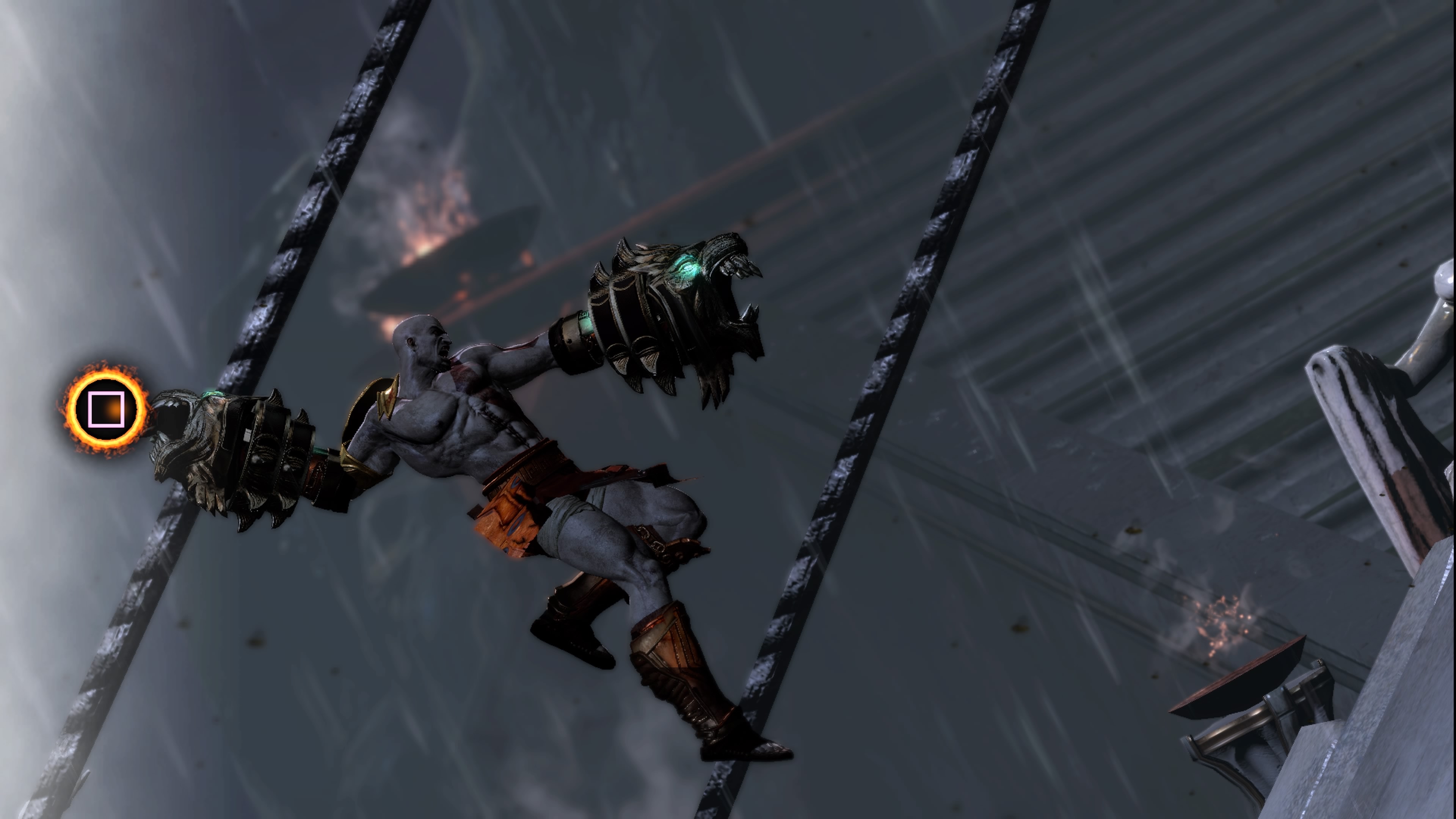

Can we give a bless up for Santa Monica putting QTE prompts on the sides of the screen that align with their orientation on the controller? You can focus on the action happening and react to the prompts from your periphery vision, whereas they appeared in the middle of the screen before. It’s great!
Items have a meter of their own that quickly recharges after a couple seconds. They deal minor damage and status effects to compensate for that advantage, so while the bow in God of War II could deal a ton of damage drawing from the magic meter, Kratos’ new fiery bow is weaker and meant to do residual damage from a distance for a couple moments. It’s also a pivotal (if not thought-provoking) item frequently used for puzzles by burning bramble blocking your path. This can be said for all the items, which aren’t essential during combat and lack compelling integration into puzzles and platforming (looking at you, Hermes’ boots and Nemesis Whip). God of War II has the edge on the latter. Regardless, you’ll want to use items frequently for special yet simple purposes, especially when you need to fall back on them if your magic meter runs out. I can appreciate how attentive the designers were to make items more prevalent, and hey, an example of that is how the bow is used for some situationally-aware combat sequences where you can fire at explosive barrels when the time’s right! It’s an underutilized extension of combat I’ve longed for with God of War, but it’s progress.
Santa Monica finally got weapons right for this entry that make compelling cases for their individual usefulness. You can get by just fine with Kratos’ Blades in the first and second games, but the third truly compels you to get more time in with the Spartan’s growing arsenal. One of the first weapons you get is Hades’ Claws. What amazed me is how they adapt all of the Blades’ moves with little foils in how they’re executed. For example, the spinning attack you do with the former is drawn out and risky since it doesn’t knock back enemies that much, but has great range and does loads of damage if used wisely. The mirrored move for the Claws is fast and circles around Kratos like a shield, brutally knocking away encroaching foes within a short range. Whereas the grapple with the Blades pulls Kratos toward an enemy with a shoulder charge, the Claws rip these floating skeletons out of their bodies that fly around and do tiny amounts of damage, sort of like the Army of Hades ability in the first game. These examples demonstrate how additional weapons no longer have less than half of the moves the Blades have always been privileged with.
A later weapon like the Nemean Cestus feels even more different since it’s essentially a pair of metal boxing gloves that send out concussive blasts, which are a slower yet exceptionally powerful alternative to the Blades. There are even enemies with shields that can only be taken out with the Cestus, which is something I’ve been clamoring for since the beginning: enemies that need to be taken out with specific weapons to foster weapon switching! Unfortunately, this strict demand isn’t applied to any other enemy types that demand you use, say, the Blades or Claws. It’s an unfortunate opportunity wasted, but this isn’t entirely squandered since I found that several enemy types were easier to take out with certain weapons. I fared better against the Satyrs with the Nemesis Whip as an illustration. It’s not their explicit weakness, but the unrelenting pace, aerial focus, and stunning electricity of the Whip – despite requiring more hits to guarantee kills – prevents Satyrs from moving an inch, which is a blessing since they’re deadly and fast once they’re on their hooves. With more enemy types and exponentially more to fight, God of War III is the pinnacle of the franchise in terms of combat that gives its host of weapons more purpose. Instead of sticking with the Blades like usual, you’ll feel encouraged to experiment with them all because each one can grant slight edges in combat that you’ll only discover with your playstyle and approach to this franchise’s easy-to-learn controls that can be richly complex if you want them to be.
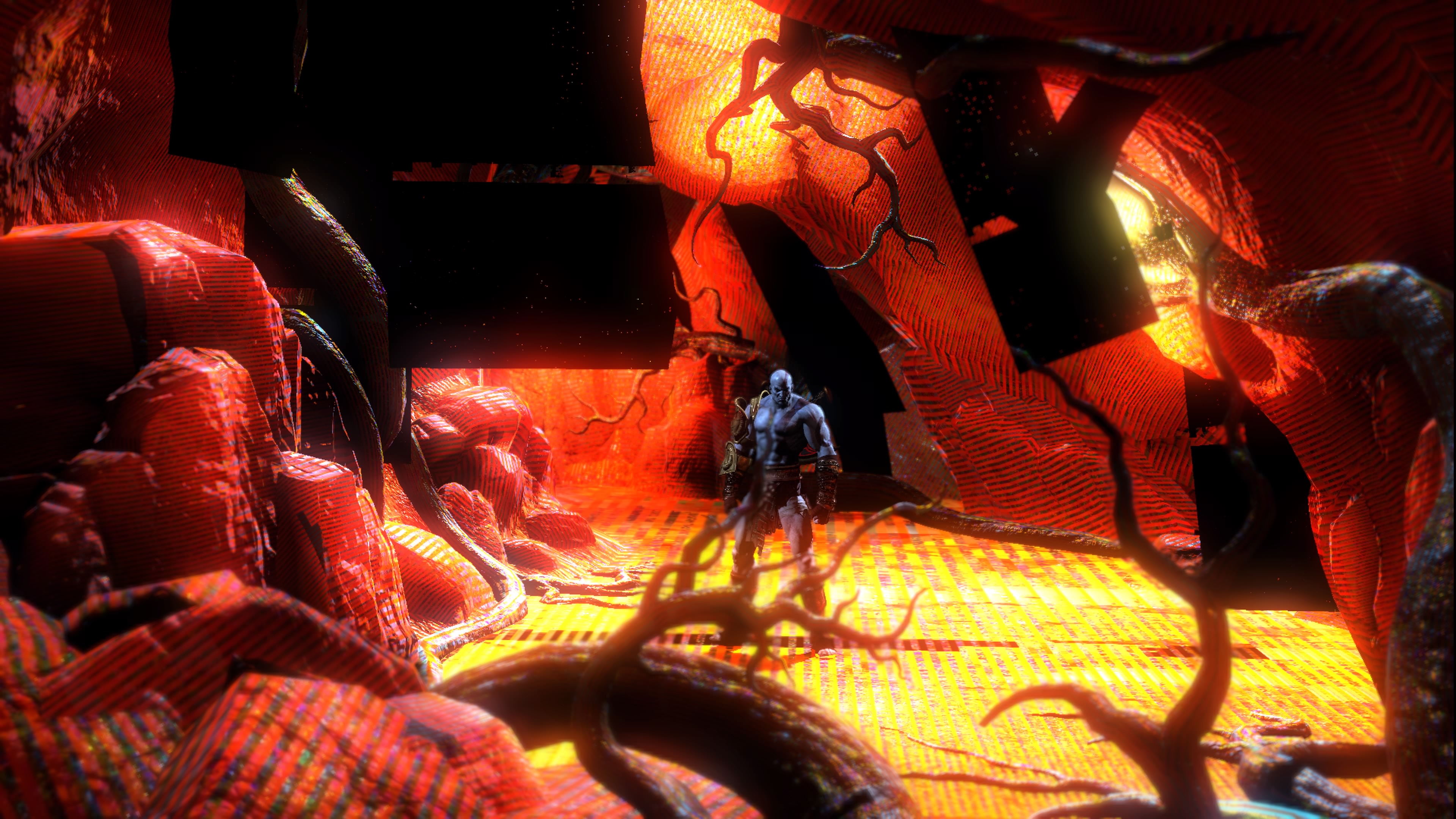
This is … an interesting texture choice! Ha, this was one of the only visual glitches I encountered in my two playthroughs of the game, so it’s not a problem worth mentioning.
The bosses left me unusually conflicted. Poseidon, Hades, Hercules, Cronos, and Zeus kept me on my toes and largely lived up to the pedigree of the franchise’s baddies, but several others left me cold and wanting more. You’d think Helios and Hermes would be major bosses, but they’re mere distractions that felt like needed concessions during development rather than ones that were intentionally skipped over. Perhaps it’s intentional to show how some of the Olympians are pushovers, but still, I’d say it’s an issue that comes packaged with my complaints about the pacing here and there. While there’s about half as many bosses compared to God of War II’s substantial lot, the third title makes up for this with the visual flair and spectacle that are densely packed into its range of bosses.
Now, onward to the periphery interests people have in God of War! The platforming is mechanically identical to the second game, but there are small adjustments to speed up traversal. One new feature includes grabbing onto harpies to fly across gaps. It’s mostly a novelty to gently help the platforming not feel repetitive in spreading out the combat and puzzles. There’s another wildly different feature with the Icarus Wings where Kratos flies upward within Mt. Olympus to reach great heights while avoiding all these obstacles. It’s a nice distraction with thrilling close calls as you barely avoid giant rocks and fit through tight corners. There are a few appreciated platform-heavy sections where you’re stressed for time or need to time your movement well. Chasing Hermes around Mt. Olympus and the Gates of Tisiphone are great examples, but my favorite platforming involves scaling Gaia and Cronos because those sections are fused together with combat in an exciting, unpredictable balance that grabs your attention.
Santa Monica learned to incorporate more puzzles with the second game, and that experience carries forward in the third with a great selection of light brainteasers. I’ve mentioned before how the developer doesn’t recycle elements for puzzles, which thankfully shows in this game as well. One puzzle incorporates portals in a clever way, whereas a garden maze has this unexpected reality-warping mechanic challenging your notions of perspective, which is definitely inspired by 3D drawings. While I wouldn’t say the puzzles are necessarily better than God of War II’s assortment, I’d wager the team devoted more time to setting them apart in concentrated areas that involve a series to tackle rather than puzzles spread out in bits and pieces. In other words, instead of smaller puzzles being spread out more, they’re often put together in larger chunks that take half an hour or more to solve altogether. I think this is better for the sake of pacing given how the puzzles don’t take long to solve individually, so that’s one area of pacing the developer made a small improvement in. But how do all of the game’s improvements and faults come together?
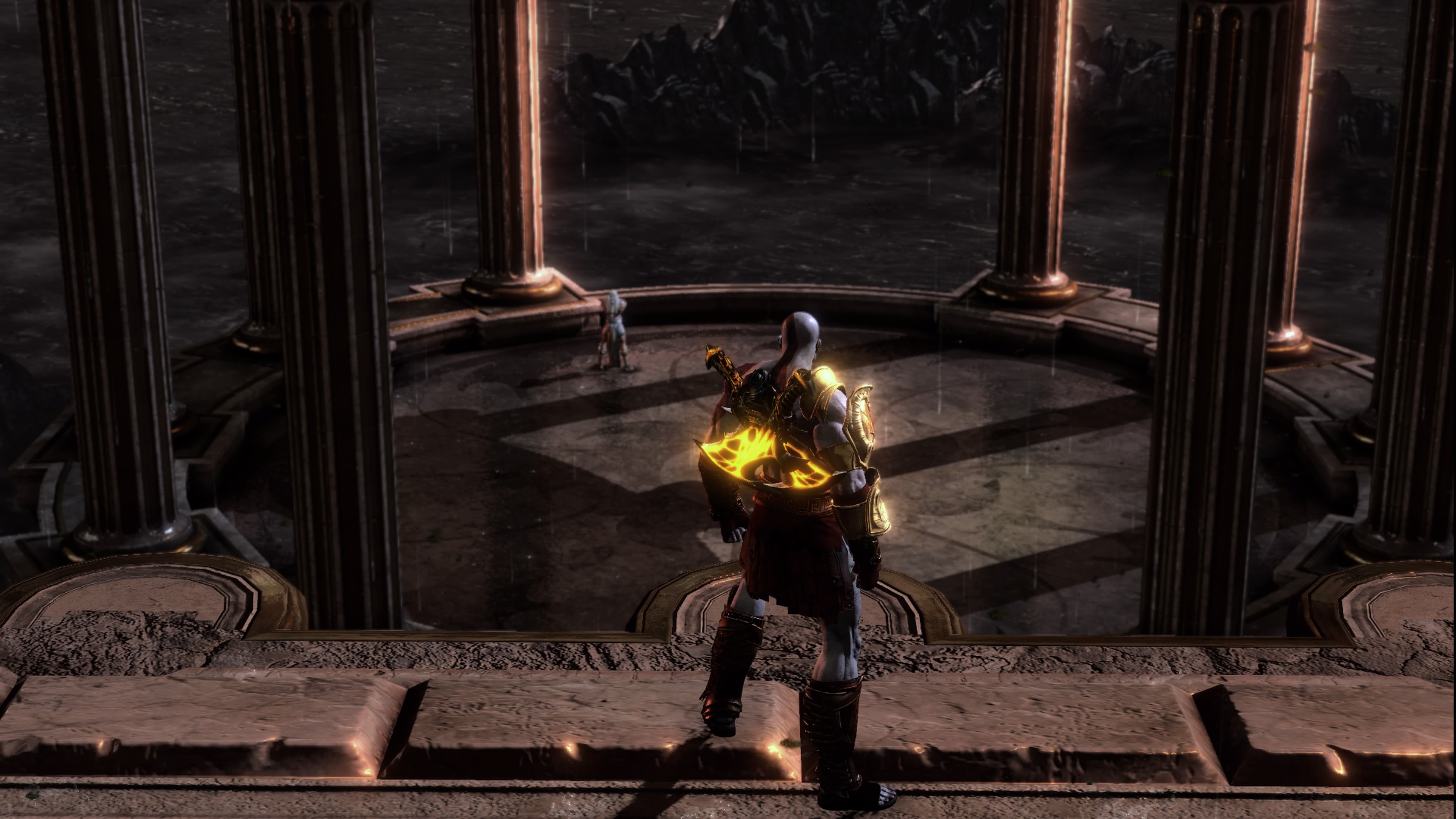
In the end … there will only be chaos.
Prescribe
It’s not uncommon to see developers buckle under pressure in living up to their own masterpieces. After all, how can you begin imagining how to topple what people can’t believe can be beat? God of War III faced that challenge with its intimidating predecessor, but it stands tall against it with a grand, epic conclusion to Kratos’ mission for revenge. Even if I couldn’t take the writing and its delivery seriously at times, I loved it for what it was, especially with its unexpectedly mature ways of forcing players to reflect on the devastation and cruelty of Kratos. The platforming and puzzles match the high bar God of War II set with several minor improvements, but the combat represents the zenith of the franchise’s potential in this area with a superb control scheme and sets of weapons, abilities, and items that have equal, exciting appeal in application. I may happen to like the setting, direction, and bosses of God of War II more than what the finale offers, but I’ll be darned if I didn’t admit that God of War III is close in my books as the king of the God of War pantheon, which closes out Kratos’ task to kill the Olympians with a rousing shout that’ll leave you in awe.


